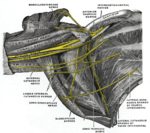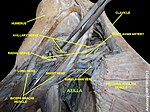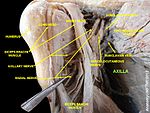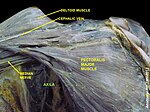Axilla
The axilla (pl.: axillae or axillas; also known as the armpit, underarm or oxter) is the area on the
The soft skin covering the lateral axilla contains many
Structure
Boundaries
Anatomically, the boundaries of the axilla are:
| superiorly: by the outer border of | ||
| medially: serratus anterior[5] and by the ribcage | anteriorly: by the
posteriorly: by the latissimus dorsi below[5]
|
laterally: by the biceps brachii)[7]
|
| floor/base: by the skin[4] (visible surface of axilla) |
The lower posterior boundary is called the posterior axillary fold and this is a compound structure consisting of the
The anterior boundary is called the anterior axillary fold and this is rounded in shape and formed by the lower border of the pectoralis major. Some sources also include the pectoralis minor.[8] It can elongate after weight loss.[9]
The contents of the axilla include the axillary vein and artery, as well as the
Contents
- Axillary artery and its branches
- Axillary vein and its tributaries
- Infraclavicular part of the brachial plexus
- Long thoracic and intercostobrachial nerves
- Five groups of axillary lymph nodes and the associated lymphatics
- Axillary fat and areolar tissue in which the other contents are embedded
-
Superficial muscles of the chest and front of the arm.
-
Axillary artery and its branches - anterior view of right upper limb and thorax.
-
The veins of the right axilla, viewed from in front.
-
The right brachial plexus (infraclavicular portion) in the axillary fossa; viewed from below and in front.
-
The left side of the thorax.
-
Axilla
-
Axilla
-
Axilla
-
Axilla
-
Axilla
-
Axilla
-
Axilla
Society and culture
The term "underarm" typically refers to the outer surface of the axilla. However, the terms are sometimes used interchangeably in casual contexts. Colloquially, underarm refers to the hollow beneath the junction of the arm and shoulder.[10]
Tickling
The underarm is a ticklish area due to the number of nerves it contains. Most people find this area to be particularly unpleasant when tickled.
Underarm hair
Underarm hair usually grows in the underarms of both females and males, beginning in adolescence.
In some modern
In the
Clinical significance
Like other flexion surfaces of large joints (groin, popliteal fossa, cubital fossa and essentially the anterior part of the neck), it is an area where blood vessels and nerves pass relatively superficially, and with an increased amount of lymph nodes.
Lymphogenic spread of breast cancer
Breast cancer typically spreads via lymphatic vessels to the lymph nodes found in the axilla.
Axillary intertrigo
Excessive
See also
- Deodorant
- Perspiration
- Popliteal fossa or "knee pit"
- Suspensory ligament of axilla
Notes
- ISBN 978-0-8160-6403-8.
- S2CID 2973690.
- ^ The Oxford Handbook of Evolutionary Psychology, Edited by Robin Dunbar and Louise Barret, Oxford University Press, 2007, Chapter 22 Body odours and body odour preferences in humans by Claus Wedekind
- ^ a b "Anaesthesia UK :AnaesthesiaUK: Applied anatomy for upper limb blocks". Archived from the original on 2008-10-16. Retrieved 2007-12-23.
- ^ a b c "LAB #4 PECTORAL REGION & Introduction to the Axilla". Retrieved 2007-12-23.
- ^ "Dissector Answers - Axilla and Arm". Archived from the original on 2007-12-10. Retrieved 2007-12-23.
- ISBN 978-80-7262-931-2.
- ^ a b lesson3axilla at The Anatomy Lesson by Wesley Norman (Georgetown University)
- ^ PMID 17602378.
- ^ "Definition of armpit - Merriam-Webster Online Dictionary". Archived from the original on 15 December 2007. Retrieved 2007-12-23.
- PMID 26663394.
- ^ "The new feminist armpit hair revolution: half-statement, half-ornament". Guardian News & Media. 24 June 2019. Retrieved 2021-06-22.
- ^ a b c Selden, Samuel Intertrigo. emedicine, WebMD. March 9, 2007. Accessed May 21, 2009.
- ^ Gardner, Stephanie S (14 June 2020). "Intertrigo". WebMD. WebMD. Retrieved June 22, 2021.
External links
- Step by step Video dissection of the Human Axilla showing all relevant anatomy
- 3D animated overview of axillary anatomy (rich media)
- lesson3axilla at The Anatomy Lesson by Wesley Norman (Georgetown University)
- lesson3axillarywalls at The Anatomy Lesson by Wesley Norman (Georgetown University)















